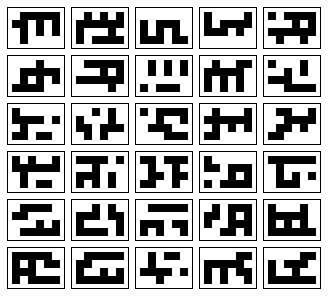Klover

- 1. Overview
- 2. Tangled File (klover.lua)
- 3. Generate Finite State machine for 2-bit rows
- 4. Operations
- 5. Generate Finite State Machine for 4-bit rows
- 6. Generate a Symbol
- 7. Demo: Proofsheet
1. Overview
(Pronounced like "clover", but with a K)
A procedurally generated system of 1-bit symbols. Suitable for large grid layouts. The hope is to make it simpler to auto-name things in this constrained interface with limited information density (letters take up too much screen space).
Klover symbols have a height of 4 bits, and variable width. Klovers, like lucky 4-leaf clovers, celebrate groups of 4. This is where the core of the name comes from.
Klover symbols use heuristics inspired by Square Kufic calligraphy to generate aesthetically pleasing symbols that are well balanced between black and white tiles. This is where Klover gets the "K".
There are many ways to generate 1-bit tilemaps that are "technically correct" Kufic. The heart of this algorithm is a finite state machine. A Klover symbol is produced one column at a time (called rows in the code sorry for the confusion). An initial column is chosen, and then the FSM is used to randomly choose which state to go to from a set of valid states. Since Klovers are 4 tiles high, they can be represented as a 4-bit number. The 4-bit FSM lookup table is dynamically generated from a 2-bit FSM.
Precursor found in the file scratch/kufbit4fsm.lua.
2. Tangled File (klover.lua)
Klover = {}
<<fsm_2bit_kufic>>
<<operations>>
<<fsm_4bit_kufic>>
<<generate_symbol>>
<<proofsheet>>
return Klover3. Generate Finite State machine for 2-bit rows
-- 2 bit kufic fsm
-- 00 -> 01, 10, 11
-- 01 -> 00, 01, 11
-- 10 -> 00, 10, 11
-- 11 -> 00, 01, 10
kuf2 = {}
kuf2[0] = {1, 2, 3}
kuf2[1] = {0, 1, 3}
kuf2[2] = {0, 2, 3}
kuf2[3] = {0, 1, 2}4. Operations
Low level operations used to manipulate rows.
4.1. split4
Splits a 4-bit row into 2 2-bit components x,y
function split4(row)
local x = (row >> 2) & 3
local y = row & 3
return x, y
end4.2. xy2row
base 4 xy pair to row
function xy2row(x, y)
x = x & 3;
y = y & 3;
return x << 2 | y
end4.3. inner2
get inner 2-bit shape in a 4-bit row.
AKA bits 'bc' in row 'abcb'
function inner2(row)
return (row >> 1) & 3
end4.4. belongs
check: does a value x belong to set 's'?
function belongs(x, s)
for _, v in pairs(s) do
if x == v then return true end
end
return false
end4.5. pstates
Calculate possible states for a given 4-bit row.
function pstates(row)
local ir = inner2(row)
local x, y = split4(row)
-- local m = kuf2[x]
-- local n = kuf2[y]
local s = {}
for _,m in pairs(kuf2[x]) do
for _, n in pairs(kuf2[y]) do
local mn = xy2row(m, n)
if belongs(inner2(mn), kuf2[ir]) then
table.insert(s, mn)
end
end
end
return s
end4.6. row2str
stringify a row, for (terminal) printing purposes
function row2str(row)
local str = ""
for i=1,4 do
local x = "-"
if (row & (1 << (4 - i))) > 0 then x = "#" end
str = str .. x
end
return str
end5. Generate Finite State Machine for 4-bit rows
The FSM structure for 4-bit columns are dynamically generated by breaking each column into 2 2-bit columns, and using the hard-coded 2-bit FSM lookup table to calculate the possible states.
-- create a 4-bit FSM that complies with kufic rules
-- use it to procedurally generate small bit patterns that
-- can be used as identifiers for tract shapes
function generate_kuf4()
local kuf4 = {}
for i=0,15 do
kuf4[i] = pstates(i)
end
return kuf4
end
function Klover.generate_fsm()
return generate_kuf4()
end6. Generate a Symbol
Function used to generate a symbol.
function generate_symbol(kuf4, len)
-- 1 thru 15 avoids 0
local symbol = {}
len = len or 6
table.insert(symbol, math.random(15))
for i=1,(len-1) do
local possible = kuf4[symbol[i]]
local next = 0
while next == 0 do
next = possible[math.random(#possible)]
end
table.insert(symbol, next)
end
return symbol
end
function Klover.generate_symbol(kuf4, len)
return generate_symbol(kuf4, len)
end7. Demo: Proofsheet
Generates the proofsheet seen at the top of this page.
function Klover.proofsheet(params)
params = params or {}
local nrows = 6
local ncols = 5
local border = 4
local width = (ncols * (48 + border*2)) + (ncols - 1) * 8 + 2*8
local height = (nrows * (32 + border*2)) + (nrows - 1) * 8 + 2*8
lil ("bpnew bp " .. width .. " " .. height)
function draw_symbol(symbol, xoff, yoff)
lil("bpset [grab bp] 0 " ..
8 + xoff * (48 + 8 + 2*border) .. " " ..
8 + yoff * (32 + 8 + 2*border) .. " " ..
48 + border*2 ..
" " ..
32+border*2)
lil("bpoutline [bpget [grab bp] 0] 1")
for y=1,4 do
local rowstr = ""
for x, row in pairs(symbol) do
local bit = row & (1 << (y - 1))
if bit > 0 then
lil(string.format("bprectf [bpget [grab bp] 0] %d %d 8 8 1",
(x - 1)*8 + border, (y - 1)*8 + border))
end
end
end
end
local kuf4 = generate_kuf4()
for row=1,nrows do
for col=1,ncols do
draw_symbol(generate_symbol(kuf4), col - 1, row - 1)
end
end
local filename = params.filename or "klover_proofsheet.pbm"
lil("bppng [grab bp] " .. filename)
end